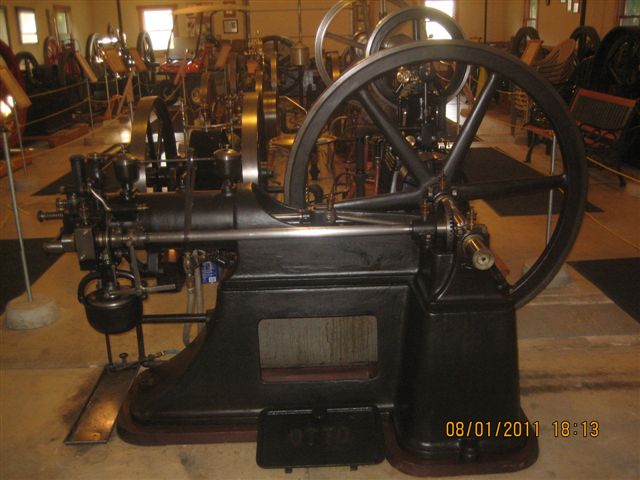
September 2011
A German Friend
By Paul Harvey
This summer has been very monumental for me in many different ways. I have taken semi-retirement from work after 41 years of medical practice and am certainly enjoying it. The museum is progressing very well with a successful June Show and the addition of two new buildings. I finally can devote more time to the museum and its development as well as enjoy life a bit more. But a big event was to attend my 50th high school reunion. When my wife and I arrived, it looked like we were going to join a bunch of old folks but then we realized that we have all gotten just a bit older after the past 50 years!
Back in 1961, Punxsy High School had a “foreign exchange student” whose name was Manfred Schultz and he was from Germany. Wow! He dressed differently from us and spoke with an accent. But over the ensuing months, Fred and I became very close friends. We were both in the band and shared most classes together. I learned a lot from him and he from me. We shared many good times together. Perhaps one advantage was that we couldn’t get in too much trouble in whatever we did as he was the student from Germany!
After 50 years, Fred and his wife Sofie returned for the class reunion and spent a day with Marilyn and me here in Coolspring. There were so many memories to recall! When Fred returned to Germany he became a college English teacher so I guess we didn’t “Americanize” his speech too much. He and Sofie have three daughters and he is now retired and they live in the small town of Hardegesen, Germany. Then, for part of their visit, we toured the museum and paid special attention to the German engines that are on display here. So here are the engines on display that we visited. The museum is proud to have such a fine collection of German engines.
Photo 1 shows Fred beside the 175 hp Otto. This is the engine from the Brookville Water Works and follows the principle of Nicholas Otto, the inventor of the 4 stroke cycle and the principle that all modern engines operate by.
Photo 2 shows the Augsburg Diesel engine and Siemens direct connected generator. This machine was built in 1903 and actually touched by Dr. Rudolph Diesel. It provided electricity for a beacon light on the tiny island of Helgoland in the North Sea. Henry Ford brought it to his museum in Dearborn, Michigan and, after being sold from there, it came to Coolspring. It actually is the first Diesel-electric plant in the world! Fred explained to me how Germany acquired this island from England by trading to them the island of Zansibar off the coast of Africa. Helgoland is in an important shipping channel and still has a beacon light. The island has huge rock cliffs and now is used as a summer resort.
Photo 3 shows the 1885 Schleicher-Schumm engine built in Philadelphia under the German license. They became the Otto Gas Engine company in 1894 and used their own designs after that. This engine uses the open flame ignition and sliding valve for intake and produces 2 hp. It was probably used in a small machine shop to power a lathe. It runs beautifully and is on display in the museum’s Susong building.
Photo 4 shows the smallest Otto built. This tiny, inverted engine produces ½ hp and was built by Schleicher-Schumm in Philadelphia. It would have been ideal to operate a sewing machine or some other small item. In the 1890s gas engines replaced steam engines by their versatility of easy starting and operation in contrast to firing a dirty boiler to operate a small steam engine.
Photo 5 is the ¾ scale model of the 1867 free piston Otto-Langen engine. This fantastic model is fully operational and built by Wayne Grenning from New York. It is copied from the actual engine on display at Rough and Tumble in Kinzers, PA. One can see it run at our June and October shows here in Coolspring. This machine predates the Otto 4 stroke cycle by being non-compressing and using a rack and pinion device to provide the rotary motion to the wheel and pulley. There is no crankshaft hence the notation of “free piston.”
The next engine is a small Heinrici hot air machine, Photo 6. These little engines are actually external combustion using a small gas flame to heat an external hot chamber. This is the Stirling cycle named for the Scottish engineer who designed the principle. It was built in Germany and probably powered a small sewing machine or jewelers lathe. It runs smoothly and absolutely quietly. The Stirling cycle is now only used for small toy engines.
The last engine, Photo 7, is a replica of the 1883 Daimler high speed engine. Daimler was interested in building small, light weight engines for their motor carriages. The original prototype was destroyed in a fire and this replica was made in 1970 to honor the original. It has been placed in running condition by Wayne Grenning. Gottleib Daimler pioneered the automotive engine and his efforts continue as Mercedes-Benz today.
It is my hope that you have enjoyed this tour of the German engines on
display here at Coolspring. Please take some time to visit Coolspring Power Museum and see
our displays. For schedules,
visit our Events page or call 814-849-6883.

Photo 1: Fred and the 175 hp Otto

Photo 2: Augsberg diesel engine and Siemens generator

Photo 3: 1885 Schleicher-Schumm engine


Photo 5: 3/4 scale model of the Otto-Langen engine

Photo 6: Heinrici hot air engine

Photo 7: Replica of the 1883 Daimler engine